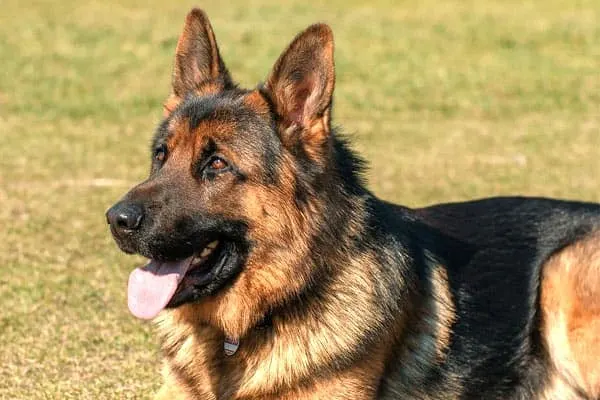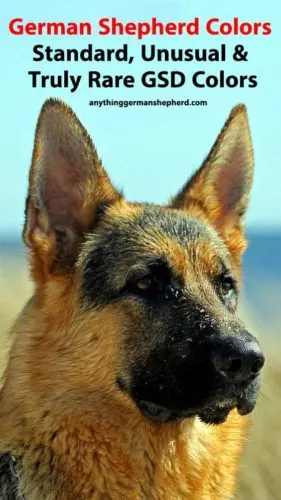German Shepherd Colors: Rare & Unusual GSD Coat Coloration
Given the German Shepherd’s huge popularity, it only makes sense that they are bred in such a variety of colors and color patterns.
This breed’s long history and varied lineage have led to certain colors being very commonly seen, while others remain quite rare.
In this article, we go into detail about the many colors and color patterns that the German Shepherd dog can have. Hopefully, this can help you decide which colors and patterns are your favorites!

German Shepherd Colors
The German Shepherd coat can be bred in six solid colors and five color patterns. However, there are many more coat colors and color patterns that are also represented in the German Shepherd breed beyond those considered “standard” or “permissible” by German Shepherd show dog standards. These rare or unusual German Shepherd colors have created more than a little debate and controversy among German Shepherd breeders.
See Examples of the German Shepherd Coat Colors
This wonderful pictorial review of the standard colors of the German Shepherd by Vom Geliebten Haus breeders offers a great introduction to breed standard colors.
This short video from the German Shepherd Man gives you another great explanation of the most common German Shepherd colors and how they can arise.
What Is the German Shepherd Breed Standard?
If you are new to dog ownership or dog breeding, you may not be that familiar with the concept of a dog breed standard.
Dog breed standards exist for every purebred dog breed that is recognized and registered through the American Kennel Club (AKC) in the United States. There are many other dog clubs around the world that have similar practices as well.
For our purposes here, we will focus on the breed standard as outlined by the main American purebred registry, the AKC.
The official AKC-registered German Shepherd breed standard governs the traits that are considered desirable or ideal in a purebred German Shepherd dog.
These traits include aspects such as personality and temperament, conformation (appearance) and size, height and weight, coat type, eye and nose color, dew claws and paw pads, tail, gait, and – the topic of our discussion here – coat color and pattern.
So in this article, you are going to learn about which German Shepherd coat colors and color patterns are permissible and desirable for the purposes of competitively showing your dog or for dog breeding.
You will also learn about unusual or so-called “rare” German Shepherd coat colors that are disallowed or disqualified for competitive show purposes and the reasoning behind that.
Learn About the Standard German Shepherd AKC-Approved Coat Colors
There are six solid colors and five color patterns that are recognized for the purposes of the official German Shepherd breed standard.
The six solid colors are black, blue, grey, liver, sable, and white.
The five color patterns are black and cream, black and red, black and tan, black and silver, and bi-color.
Of the six solid colors that are mentioned in the breed standard, white is disqualified for the purposes of competitively showing your dog through the AKC.
The breed standard makes it very clear that “strong rich colors” are preferentially judged over “pale or washed-out colors.”
The breed standard also makes it clear that the liver or blue colors will be judged as “faults” in the show ring.

Why Are Some German Shepherd Colors Preferred Over Others?
As you are probably already starting to perceive, when it comes to participating in dog shows as a competitor or breeding German Shepherds in hopes of winning such awards, certain coat colors and color patterns are strongly preferred over others.
But why is this, exactly?
After all, the man who founded the German Shepherd dog breed itself, a German cavalry officer by the name of Captain Max von Stephanitz, did not care at all what coat color his German Shepherd dogs had!
As the German Shepherd Rescue Elite charity explains, Captain von Stephanitz bred German Shepherds for one purpose and one purpose only. He wanted to create the ideal working and herding dog.
In fact, the very first German Shepherd dog was a dog that Captain von Stephanitz saw at a dog show, purchased, and began using as his stud (male) dog. He was rumored to be a wolf-dog hybrid and certainly his lineage and pedigree were unknown.
For a time following World War II when anti-German sentiment was at an all-time high, the German Shepherd breed was even renamed the Alsatian Wolf Dog, which is thought to perhaps be a recognition of the breed’s hybrid wolf-dog origins.
Unfortunately, in order to create his perfect working dog, von Stephanitz in-bred his prototype dogs heavily (breeding within a dog family). Later, von Stephanitz added other breed lines to give more diversity to the gene pool for health reasons.
One theory regarding why some German Shepherd coat colors and color patterns are strongly preferred and others are disallowed or discouraged is because the rarer colors may point to genetic faults from inbreeding the German Shepherd preferentially for color alone.
What Are the Preferred German Shepherd Coat Colors and Color Patterns?
According to the German Shepherd Dog Club of America (GSDCA), “most colors are permissible.”
However, the club’s official AKC breed standard also makes it clear that certain colors and patterns are strongly preferred over others – in particular, strong and rich colors.
So which colors will receive preferential scoring in a competitive setting?
As the German Shepherd Elite Rescue charity explains, two colors and color patterns are vastly preferred above the rest:
- Black and tan
- Black and red
In addition, color patterns that are preferred emphasize black masks, black “saddles” (named for a horse’s saddle), and black “blankets” (named for a horse’s blanket.
These are also the colors and color patterns that are most closely associated with the German Shepherd dog breed even in popular culture and in mainstream media.
An all-black or sable colored German Shepherd coat is also typically acceptable in the show ring, although maybe judged less preferentially in some dog club circles.
The sable coat color is actually a pattern where the hair is black-tipped with a lighter contrasting color as the hair gets closer to the skin. The color is usually some variation of cream, tan, or silver/grey.

Which Colors Are Considered Rare or Fault Colors in the German Shepherd?
The German Shepherd can also be bred in so-called “rarer” colors, which include any shade of blue, liver, cream, or white.
Here you might be wondering how a dog’s coat could be blue? Is that even possible?
Or how about the color liver or sable? What colors are these?
To understand where the references to these less-common colors coats come from, it helps to know a little bit more about canine coat color genetics.
The same holds true for coat colors and color patterns that are disallowed, so we will talk much more about canine coat color genetics here shortly.
What German shepherd Coat Colors and Patterns Are Disallowed or Disqualified for Competitions?
Right now, the coat color that is outright disallowed or even disqualified on sight for AKC dog competitions is white.
As von Haus Ulv German Shepherds breeder explains, the main reason that the white color is automatically disqualified is that the breed founder, Max von Stephanitz, specifically stated that a white coat is a “danger for breeding.”
The white is not a coat color at all, actually, but is an absence of color pigment for the coat. This is not the same as an albino, but it is viewed as a genetic weakness in many working dog lines, including the German Shepherd dog.
As this popular German Shepherd breeder and owner forum showcases, the presence of any white in a German Shepherd dog can quickly produce intense debate and disagreement.
Another very rare color that is sometimes called the Panda Shepherd is the piebald (piebald) color pattern. In horses, the pattern, with its white spots interspersed with color patches, is sometimes called the “paint.”
The brindle coat pattern, which is sometimes nicknamed a “tiger stripe” pattern, is also strongly discouraged and judged to be a fault in show competitions.
Understanding the Basics of Canine Coat Color Genetics
As VCA Animal Hospitals explains, coat color and color pattern in any canine is determined by the specific genetic mix inherited from the parent dogs.
This is why two puppies from the same exact litter can grow up to have two completely different coat colors or color patterns.
Even German Shepherd breeders that have years or decades of experience working canine coat color genetics still get “surprises” sometimes when they breed their dogs. There is always more to learn.
But here is a basic overview so you can at least get your feet wet and start to understand how rare or unusual colors can happen in German Shepherd dogs.
Two Main Color Genes: Eumelanin and Phaeomelanin
As Dog Coat Colour Genetics points out, there are two main genes known to encode for coat color in dogs, eumelanin and phaeomelanin.
Let’s take a closer look at the role of each in determining a German Shepherd puppy’s adult coat color.
Eumelanin
Eumelanin (pronounced “you-mel-ann-in”) is the gene that expresses as basic black.
Phaeomelanin
Phaeomelanin (pronounced “fee-oh-mel-ann-in”) is the gene that expresses as basic red.
As Vom Slekira Kennels explains, each German Shepherd puppy will inherit one gene for coat color from each parent dog.
There are two kinds of color genes: dominant and recessive. A German Shepherd puppy only needs to inherit one dominant gene from either parent dog to express that color in the adult coat.
The dominant colors are much more common in the German Shepherd breed because they are much easier to breed for.
But in order to express a recessive color gene, the German Shepherd puppy will need to inherit two copies of that color gene – one from each parent dog.
This is why recessive colors are rarer and harder to breed for. This is also why they are often said to be unusual colors.
In the German Shepherd gene pool today, these are the “rich” or “strong” coat colors that are preferred, listed in order from “most dominant” to “least dominant”:
- Sable
- Black and tan
- Bi-color
- Black
So let’s take a closer look at each one of these colors and color patterns and the genetics behind them.
Sable
According to breed founder Max von Stephanitz, the foundational coat color pattern for the ideal German Shepherd Dog should be a yellowish wolf color background that evolves into a darker grey or black.
This is the hallmark of the sable color pattern, with the black tips and the lighter hair color nearer the skin. It gives a mysterious ripple effect as the dog moves.
The sable color is often also called “agouti,” which is a term that describes the dark-to-light pattern of each hair.
It may be the closest to the original color pattern of Captain von Stephanitz’s original founding dog, Horand von Grafath.
The German Shepherd Dog Club of America (GSDCA), in its breed history, describes this founding dog as a “primal canine type” in appearance and a sheepherder working dog by profession.
Black and tan
The black and tan coat typically expresses genetically in a saddle pat
The darker colorations are typically seen over the mid-body area – similar to where a saddle would sit if dogs wore saddles.
The black and tan color is usually seen with a black facial mask well.
Bi-color
The bi-color coat has a lot more emphasis on the black color than the black and tan color. A true bi-color coat will have black extensively across the head and body and lighter tan, gold, or cream only on the lower legs and paw pads.
Breeders often refer to the all-black portions of the coat as the saddle or, alternatively, the blanket pattern.
Black
The black coat color in a German Shepherd dog is considered a true recessive gene. This is important to know when we look at how to dilute or pale (the breed standard calls them “washed out”) colors may arise in the coat.
As you may recall, eumelanin is the gene that codes for the black and the black spectrum.
But other genes can interact with eumelanin to change how the black shows up in the coat. This is a much more complicated aspect of color genetics in dogs, but suffice it to say that when eumelanin is lightened, it can turn into a blue or gray coloration.
What About the Other Coat Colors Mentioned in the German Shepherd Breed Standard?
We just discussed how the eumelanin gene for black coat color can interact with other genes to create color dilution. This may show up as the blue color discussed in the German Shepherd breed standard.
The liver is the other main coat color that is considered a fault yet is not disallowed outright from show competitions.
As you likely remember from our discussions here earlier, phaeomelanin is the color gene that expresses the red color spectrum.
At its lightest, phaeomelanin may appear to be ivory, cream, yellow, gold, tan, khaki, orange-red, etc. At its darkest, phaeomelanin may appear as burnt red, mahogany, russet, umber, or a rich reddish-brown.
The liver is along the lighter spectrum of dilute or washed-out phaeomelanin. When other color expression genes interact with phaeomelanin, they can lighten the red to a pale muted fawn that some call liver or red-fawn.
In German Shepherds, the liver can also look like a solid reddish-brown. As That Dog Place explains, if a German Shepherd inherits the liver dilution genetics from both parent dogs, they will likely grow up to have a darker red-brown liver coat color.
What About Breeders That Say Rare Colors Should Be Standard German Shepherd Colors?
One reason there are so much debate and controversy regarding German Shepherd coat colors is that breeders cannot agree on whether less-common coat colors reflect genetic fault.
For example, K-9 Pines German Shepherd breeder is a kennel that actually chooses to specialize in breeding colors that are commonly viewed as genetically flawed.
This breeder focuses on the blue, brindle, white, piebald, liver, and fawn coat colors and color patterns.
Part of the controversy arises from how the American Kennel Club issues AKC papers to German Shepherd puppies.
As long as the breeder can prove that the puppy’s lineage (parents, grandparents, great grandparents, et al) all came from purebred AKC-registered German Shepherd bloodlines, the puppy is eligible to be registered as a purebred AKC German Shepherd dog.
This is why there are German Shepherd breeders that are breeding purebred AKC-registered German Shepherds that have coat colors that would be judged at fault or not even allowed in the show ring.
Rare & Unusual German Shepherd Colors: Can This Impact Health?
The Orthopedic Foundation for Animals Canine Health Information Center (OFA-CHIC) database maintains information about current recommended and/or required genetic health tests for many different purebred dog breeds.
OFA-CHIC partners with the American Kennel Club’s Canine Health Foundation to maintain up-to-date and accurate health records for each registered purebred dog breed.
Breeders can voluntarily contribute test results for their parent dogs to add to the knowledge base for other breeders and the dog community as a whole.
Breeders that contribute data to the CHIC database can be issued a CHIC certification number. This is useful for sharing with prospective puppy buyers.
While CHIC is very clear that negative test results do not necessarily rule out future health problems, it certainly lessens the risk and provides the buyer with some level of peace of mind.
If you are considering making a lifetime commitment to any German Shepherd puppy of any coat color or color pattern, you should request the OFA-CHIC test results for the parent dogs from the breeder before making your commitment.
Currently, CHIC recommends that German Shepherd dog breeders perform the following pre-screening health tests on their parent dogs:
- Hip dysplasia
- Elbow dysplasia
- Temperament test
- Autoimmune thyroiditis
- Degenerative myelopathy
- Cardiac issues
- Eye problems
As you can see, this is quite a list of tests!
How does this affect rare or unusual coat colors?
Some genes that interact with color, such as merle, are also known to interact with other genetics that can cause health problems or birth defects, or even early fatality.
For German Shepherd dogs, the white/piebald and the brindle coat color gene is the gene most frequently targeted as being potentially problematic health-wise.
However, here again, there is no uniform consensus among canine geneticists, biologists, or breeders as far as what the risk is and how to know for sure if the coat color will be linked to health problems.
The truth is, genetics as a field (in any species) is still quite young.
This means the best way to choose your puppy is to work with a health-focused breeder that will show you test results, let you meet the parent dogs, and provide you with records of immunizations and an initial guarantee of puppy health.
Right now, the official German Shepherd dog breed standard favors some colors and patterns over others. As with every aspect of purebred dog breeding, this can and sometimes does change over time.
As Captain von Stephanitz said, “the coloring of a dog has no significance whatsoever for service.”






























